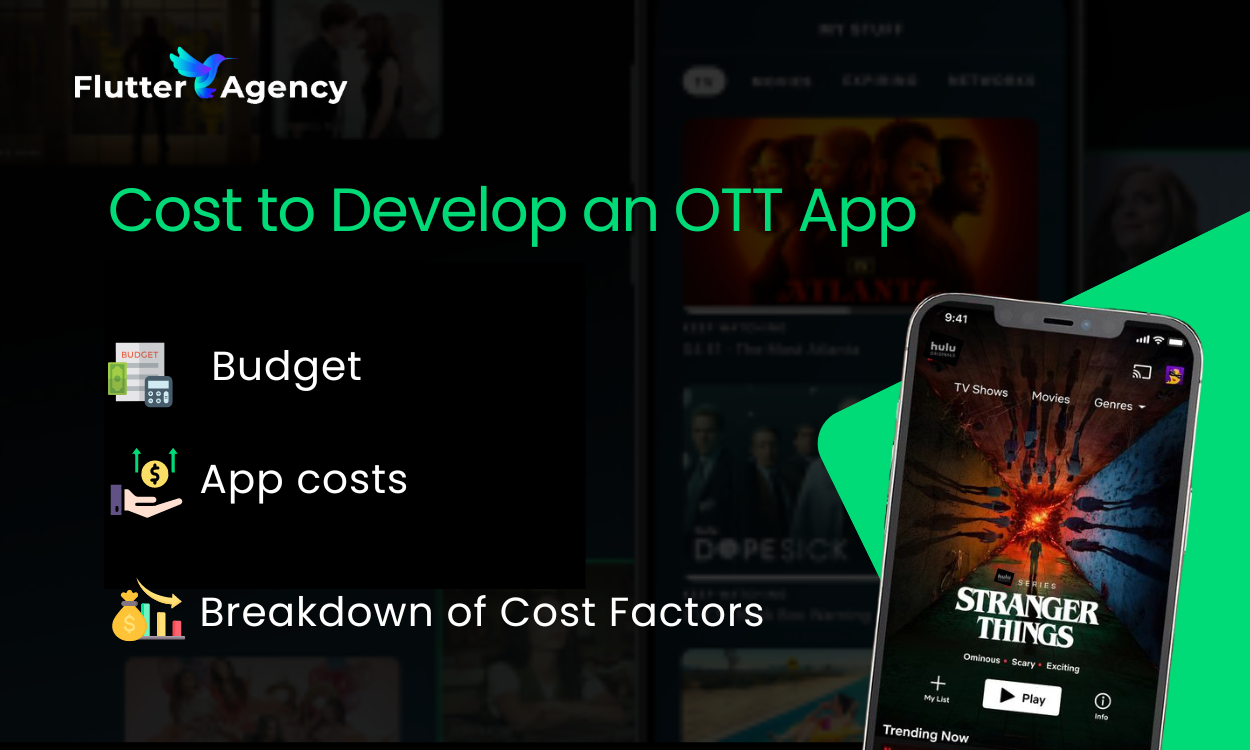How to build a cost-effective OTT app like Hulu?
Streaming services have upended entertainment in recent years. On-demand content now flows to viewers whenever and wherever they want. These over-the-top platforms deliver shows and movies directly, bypassing traditional distribution channels. The shift has transformed how we watch, giving us unprecedented control and choice. They offer more flexibility than traditional TV’s rigid schedules.
Streaming giants Netflix, Disney+, and Hulu spearhead a worldwide entertainment revolution. More viewers prefer this convenient, customizable option.
OTT platforms soar as viewers crave personalized content. This surge sparks a parallel demand for tailored mobile app development, creating a symbiotic relationship between streaming services and app creators. These services help platforms deliver smooth, user-friendly experiences. They tailor them to diverse audiences. This makes OTT the top choice for entertainment.
What is OTT?
OTT (Over-the-Top) platforms are media services.
They deliver content directly to viewers online, bypassing cable or satellite TV. OTT platforms differ from traditional TV channels. They offer a vast library of on-demand content. This includes movies, TV shows, live events, and original productions.
Streaming services also deliver content online. This lets viewers watch videos on phones, tablets, smart TVs, and computers.
These platforms use advanced algorithms, cloud services, and smooth data streaming. This lets viewers enjoy high-quality content with minimal buffering. Hulu has used new technologies to improve user experiences. It offers personalized recommendations and ad-free viewing on multiple devices.
As OTT grows, custom mobile app development is key to success. It ensures apps perform well, engage users, and stream smoothly on all mobile devices.
Market overview and future trends
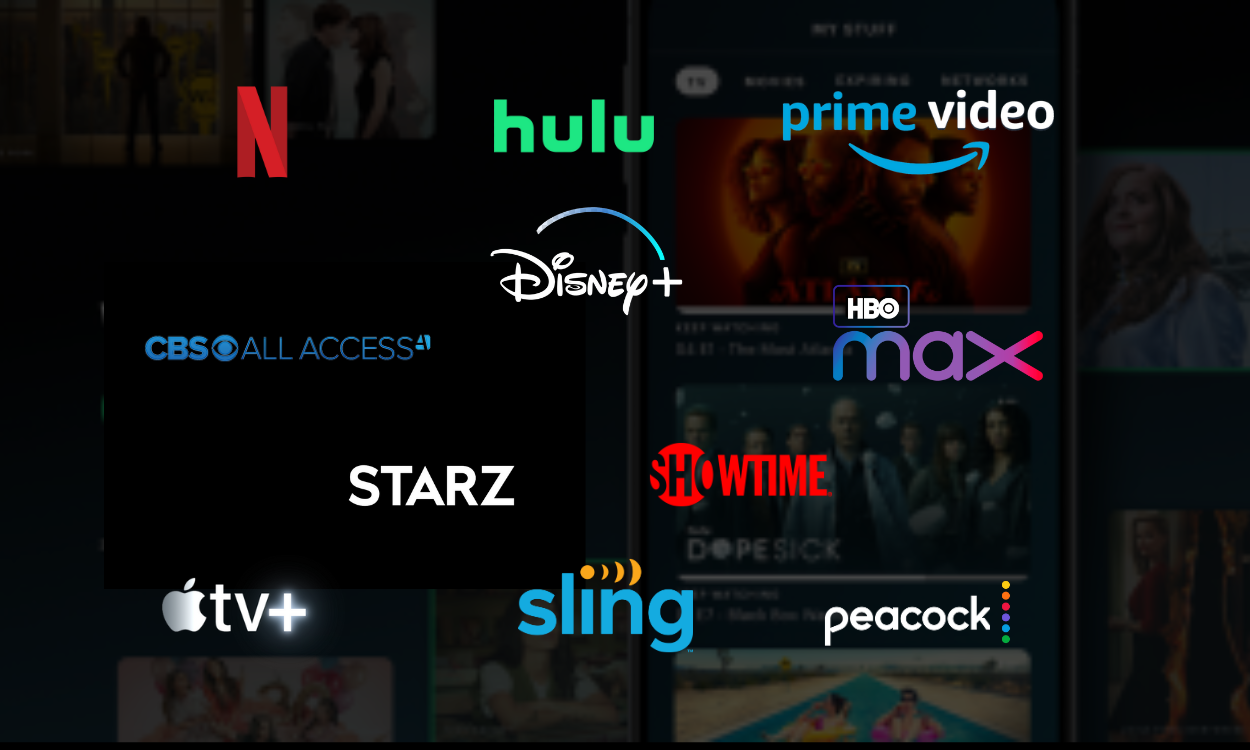
OTT services have seen huge growth in their global audience. Viewers flock to on-demand video streaming apps, abandoning traditional TV by the millions. This seismic shift reshapes entertainment consumption. Audiences crave flexibility, personalized content, and ad-free experiences. Streaming giants battle for subscribers, investing heavily in original programming. Meanwhile, cable companies scramble to adapt or risk obsolescence. As streaming devices flood homes, the living room transforms. Smart TVs now reign supreme, ushering in endless binge sessions. Algorithms shape our viewing habits, offering personalized picks at every turn. The way we consume media shifts, marking a new chapter in home entertainment. Growth will likely speed up. More consumers want easy, personalized access to their favourite content. Markets in Asia, Europe, and the Americas will see a big rise in users. This is due to better internet access and more content options.
Also Read: 12 Simple Steps to Develop an On-demand Video Streaming App
Future trends show OTT app development is shifting. It’s moving toward better integration with smart TVs, voice control, and interactive features. Live streaming surges for sports, concerts, and news, making OTT platforms the prime real-time entertainment source. As immersive tech evolves, AR and VR will transform OTT experiences, offering users captivating new ways to engage with content. This shift promises a more interactive future for digital media consumption.
To stay ahead, many OTT platforms want to hire Flutter developers. They need cross-platform apps for seamless streaming on iOS and Android devices. Responsive, feature-rich OTT apps thrive on Flutter’s nimble framework. Its adaptability and swift performance empower developers to craft dynamic streaming experiences with ease.
Why invest in an OTT app like Hulu?
OTT apps like Hulu are popular now. People want on-demand content for its flexibility and convenience.
As more people leave traditional TV for streaming, businesses see great potential in custom mobile apps for OTT platforms. These services let businesses create solutions for their target audiences. They can use personalized recommendations, multi-device streaming, or exclusive content.
The OTT market has huge revenue potential. Projections show it will grow rapidly. Cord-cutting trends fuel explosive growth in the OTT market, projected to eclipse $250 billion by 2027. This seismic shift presents lucrative prospects for companies seeking to capitalize on streaming’s ascendancy. Digital platforms surge as cable falters. Smart companies seize this moment, innovating and growing in a flourishing sector brimming with untapped possibilities.
Netflix, Hulu, and Disney+ have made waves in entertainment. These streaming giants reshape how we consume media, challenging traditional TV and film. Their success stories reveal the power of on-demand content and personalized viewing experiences in today’s digital landscape.
Netflix transformed marathon-viewing and membership frameworks. Hulu combined live TV and on-demand content. Both set new standards for user experience.
Disney+ quickly became a dominant player with its vast content library and strong brand presence. These platforms show a demand for innovative OTT services. They also show that custom mobile app development can drive success in the industry.
Top features of an OTT app
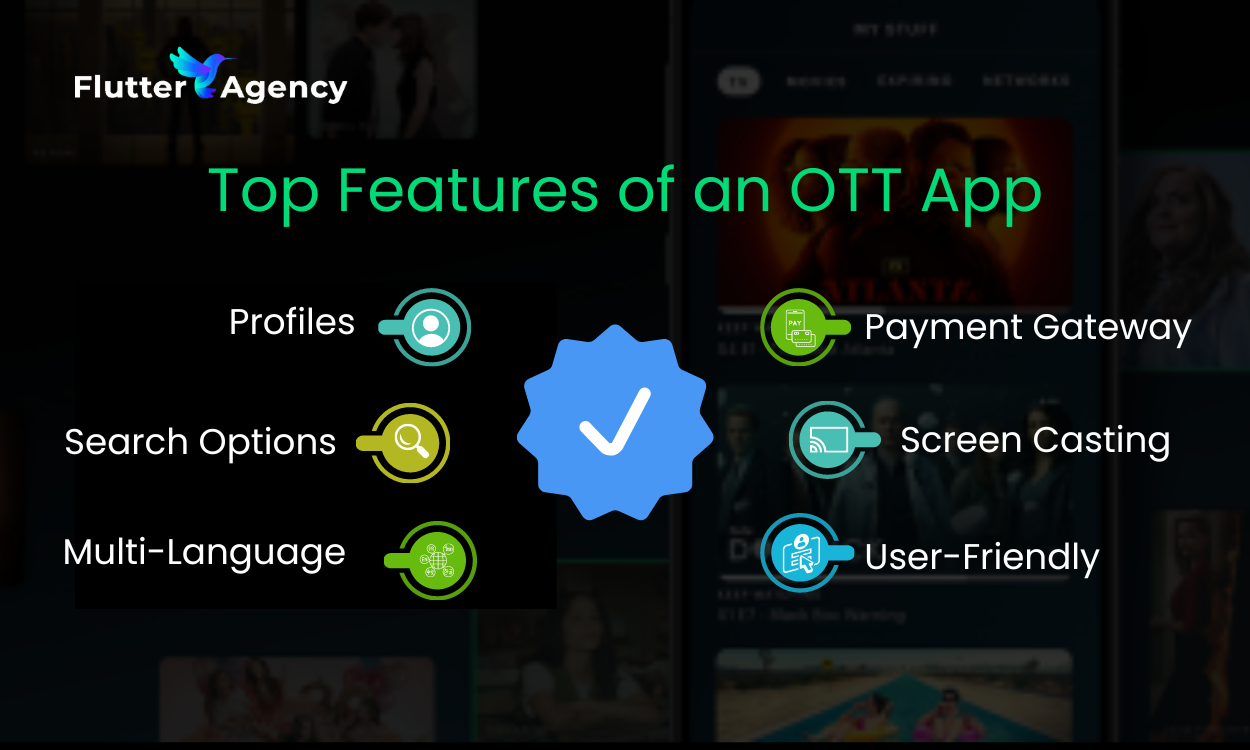
- Personalized profiles: This feature recommends content based on the user’s viewing history. This customization improves the user experience. It makes it easier to find relevant shows and movies.
- Smart search options: Users can quickly find content with advanced search. It has filters, suggestions, and voice search. Content discovery flows effortlessly with intelligent search. Seamless efficiency defines this process, enhancing user experience. Smart algorithms sift through data, delivering relevant results swiftly.
- Watchlist: Users curate their own media library with a watchlist. Saving favourites for later boosts retention and flexibility. This personalized collection fosters a sense of ownership, keeping viewers engaged and coming back for more. A simple feature with a powerful impact on the user experience.
- Multi-language support: Multilingual options unlock worldwide appeal. Global reach demands diverse language support. This feature helps platforms reach new markets. It provides content and UIs in multiple languages, boosting accessibility and inclusivity.
- Payment gateway integration: An OTT app can increase subscriptions. It can do this by offering multiple, secure payment options. Users can enjoy seamless transactions when purchasing or leasing content. The process eliminates friction, providing a sleek and effortless experience.
- Screen casting: Users crave flexibility in their viewing habits. The app’s casting feature delivers, enabling content to leap from small screens to TVs and projectors. This cross-device feature meets a need in today’s mobile world. Entertainment follows viewers everywhere they go.
- User-friendly design: A smooth viewing experience depends on a straightforward, easy-to-understand design. OTT apps thrive with easy navigation and pleasing aesthetics. Smooth functionality across devices keeps users engaged. An effortless UI/UX is the cornerstone of user retention and satisfaction in the streaming world.
Monetization models for OTT apps
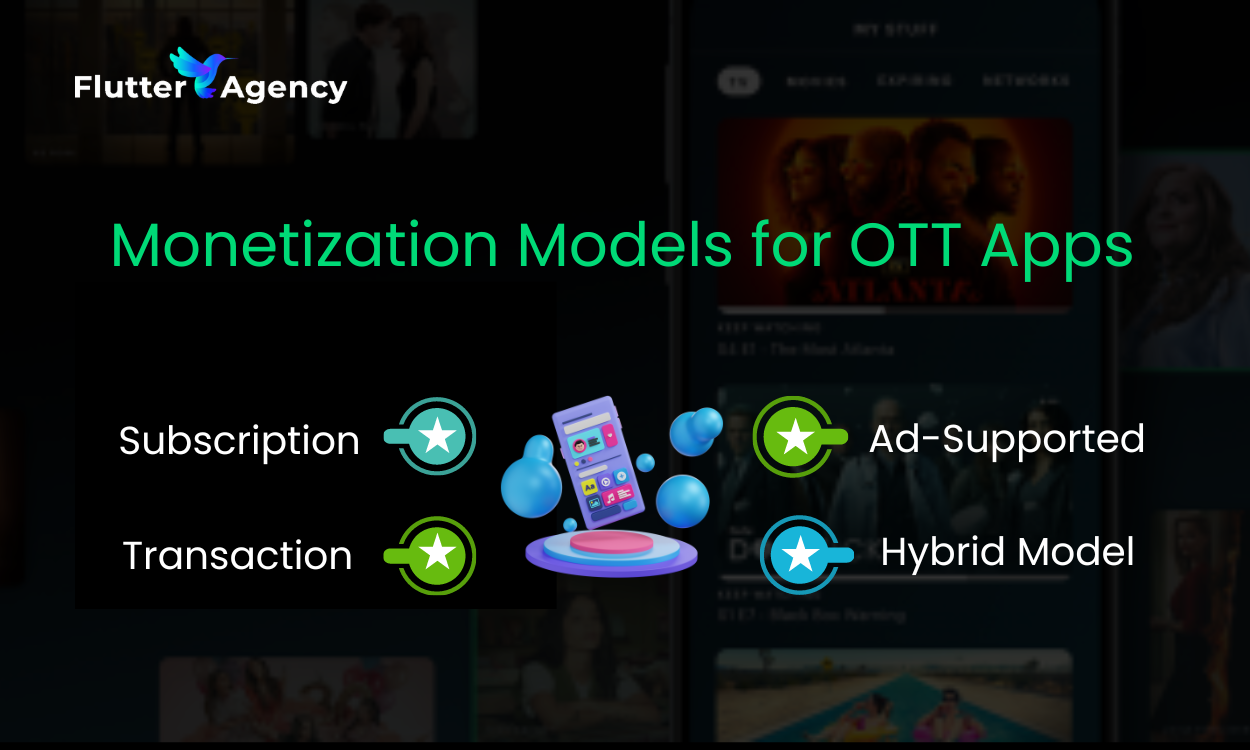
- Subscription-based (SVOD): Subscription-based platforms dominate content monetization. Netflix and Hulu exemplify this model, offering unlimited access for a recurring fee. Users enjoy diverse content while companies secure a steady income. This win-win approach fuels the streaming industry’s growth, satisfying both providers and subscribers alike.
- Ad-Supported (AVOD): Free content comes with a catch: ads. Users watch commercials instead of paying. Platforms profit from advertisers, not viewers. This model flips traditional funding on its head, making entertainment accessible while keeping companies afloat through strategic marketing partnerships. This model is ideal for attracting a larger audience base that prefers free content.
- Transaction-based (TVOD): In a pay-per-view system, users pay for individual content, like movies or events. They do not subscribe to the platform. It lets users access premium content on demand. It offers flexibility for those who don’t want a full subscription.
- Hybrid Model: Many OTT platforms now use a hybrid approach. It combines subscription, ad-supported, and pay-per-view options. This model is flexible. It caters to different audience preferences. It also maximizes revenue by using multiple channels. It allows platforms to reach a wider audience by offering both free and paid content options.
Steps to build an OTT app like Hulu
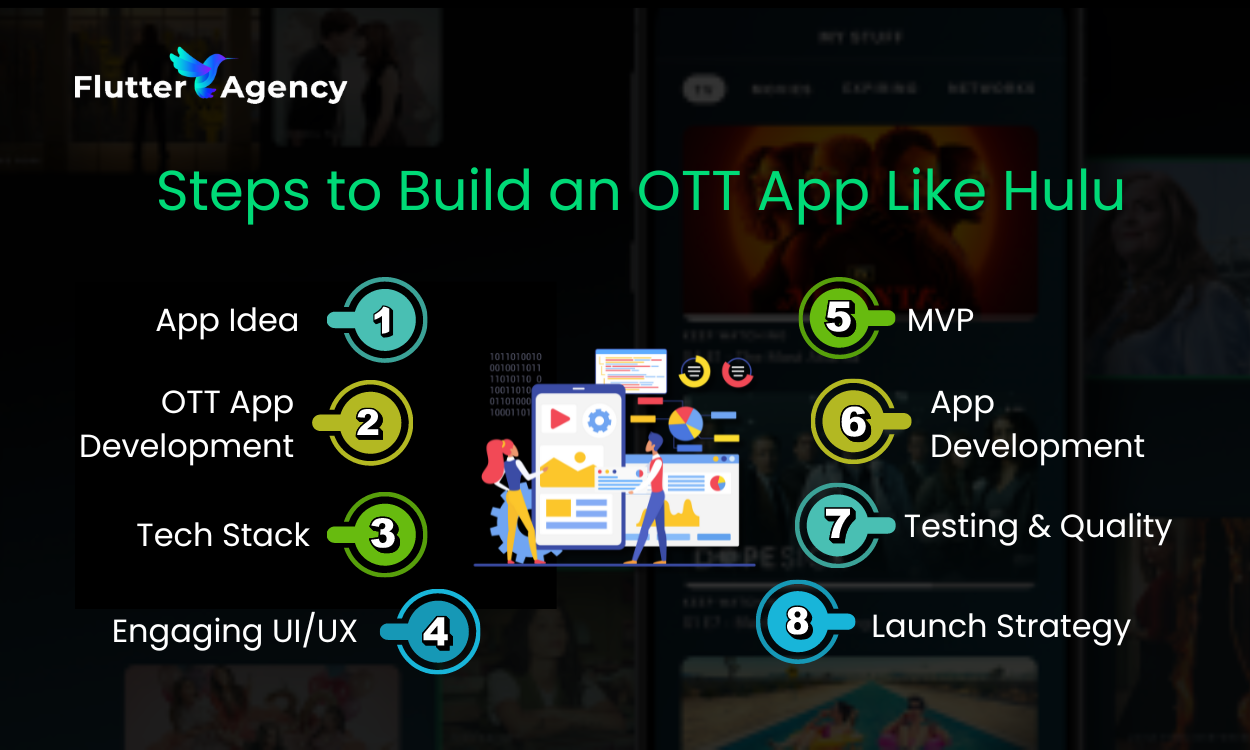
- Defining the app idea: First, identify your target audience. Then, show how your app is different from competitors. Research the market. Know user preferences. Find unique features to set your OTT app apart.
- Consulting with OTT app development experts: Partner with a trusted firm that specializes in custom OTT apps. Consider hiring Flutter Mobile App Developers. They are experts in building fast, scalable, and cheap apps with great UX.
- Choosing the right tech stack: Choose scalable, high-performance tech for video streaming, real-time analysis, and secure transactions. Your stack should prioritize speed, reliability, and ironclad security measures. Opt for proven solutions that can handle growth while maintaining robust user protection. It must also handle high-traffic loads efficiently.
- Designing an engaging UI/UX: From sleek phones to expansive desktops, our design adapts flawlessly. Users navigate with ease, guided by clear pathways through content. Striking visuals enhance the journey, creating an immersive experience. Form and function unite in perfect harmony, captivating visitors at every turn. The result? A stunning, intuitive site that delights users across all devices.
- Build the MVP (Minimum viable product): Stream, profile, pay – these core features form your MVP. Launch quickly to gather user feedback. Refine and improve based on real-world data before the full release. This lean approach maximizes efficiency and reduces wasted effort.
- App development process: Move from design to backend development. Incorporate all essential features: content streaming, user management, and recommendation algorithms. Ensure proper content delivery mechanisms (CDNs) and high-end security protocols.
- Testing and quality assurance: Test the app on various devices and OS. Ensure it works smoothly. Test performance, find bugs, and check security. Ensure an error-free experience for users.
- Launch strategy: Create a launch plan. It should promote the app on various platforms. It should optimize your app store listing. It should use social media marketing to attract initial users.
Post-launch support and maintenance

- The Importance of regular content updates: To keep users engaged, use fresh, updated content. Fresh content fuels user engagement. Frequent updates to your streaming library keep viewers coming back for more, ensuring your OTT platform stays relevant and exciting.
- Bug fixes, feature additions, and continuous improvements: Apps evolve after release. Fixing glitches, boosting speed, and adding capabilities keeps them sharp. Continuous improvement is key to staying ahead in a crowded market. No software launches flawlessly, but swift updates can polish rough edges and delight users. mobile app development service can help. They can tailor updates based on user feedback and trends.
- Providing ongoing user support: Quick, effective support breeds loyal users. Rapid responses and adept problem-solving boost satisfaction. Excellence in customer care fuels enduring success, cementing user relationships for the long haul.
Cost to develop an OTT app
1. Breakdown of cost factors
- Design: UI/UX design to ensure a smooth and appealing user experience.
- Development: Core functionalities like streaming, user profiles, and payment integrations.
- Integrations: Third-party integrations enhance site functionality. CDNs speed delivery, payment gateways process transactions, and analytics track performance.
- Post-launch maintenance: Post-launch, websites require continual care. Regular updates, optimizations, and support keep sites running smoothly and securely.
2. Typical budget range for developing an OTT app like Hulu
App complexity drives costs skyward. Hulu-like projects demand $100,000 to $500,000. Features, integrations, and platform support determine the final price tag. Developers must balance ambition with budget constraints. Smart planning minimizes expenses while maximizing functionality.
3. App costs hinge on several key elements
Feature count shapes pricing, with options like profiles or language support adding complexity. Integration intricacy also impacts expenses. Platform choice – iOS, Android, or web – further influences the final tally. These factors intertwine, determining your app’s ultimate price tag. Businesses seeking efficiency and cost-effectiveness often turn to Flutter developers. This versatile framework enables the creation of apps for multiple platforms using one codebase, streamlining development and reducing expenses.
Build Your OTT App Now!
Start building your own OTT app like Hulu at a low cost.
Conclusion
Building an OTT platform offers huge opportunities. It lets businesses meet the rising demand for on-demand entertainment. A well-made app like Hulu can be very profitable. It can use different ways to make money. It can also reach a global audience with its advanced features.
The OTT market has vast potential for startups and established businesses. It is driven by changing user preferences and a shift to digital streaming. By using custom app development and top developers, companies can create a unique platform. Seize the moment. Launch your OTT app now to capture a slice of this thriving market. With skilled partners, cutting-edge technology, and a solid plan, you’ll create a standout streaming service. Don’t wait – your competitive edge awaits.
Contemporary ventures
Recent blog
ready to get started?
Fill out the form below and we will be in touch soon!
"*" indicates required fields






